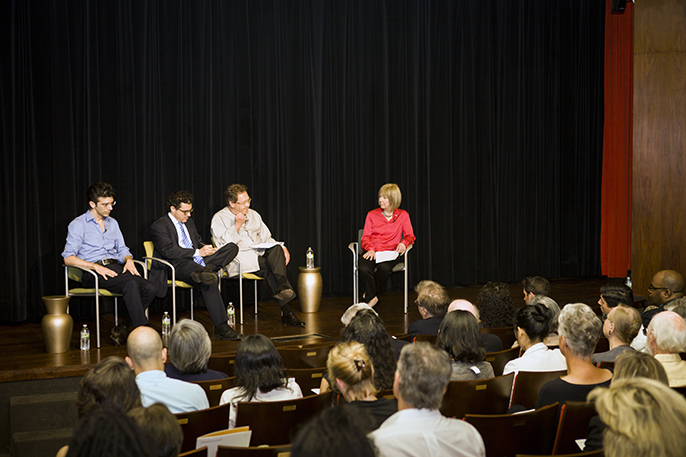PANELISTS DISCUSS THE FUTURE OF DESIGN
 L–R: Kevin Slavin, Jonathan Bowles, Peter Barna, Linda Tischler
L–R: Kevin Slavin, Jonathan Bowles, Peter Barna, Linda Tischler
How can designers prove their economic value matches their aesthetic value in today’s global economy?
This was one of the questions that panelists grappled with during a wide-ranging discussion, titled Differentiating by Design: How the Creative Community Will Drive the Next 125 Years, on May 20 at the Museum of Art and Design in Manhattan.
Linda Tischler, a senior editor at Fast Company, moderated the panel, which included Provost Peter Barna; Jonathan Bowles, executive director for the Center for an Urban Future, a Manhattan-based think tank; and Kevin Slavin, entrepreneur and founder of Playful Systems group at the MIT Media Lab. The discussion focused on how design innovation will shape the future and how best to prepare and inspire up-and-coming designers to thrive in the creative economy.
The conversation inevitably went to New York City. “There are about 40,000 designers in New York City. The city with the next highest number is Los Angeles, with about 23,000,” said Bowles. “New York City also graduates twice as many students in design and architecture as any other city in the U.S.”
“Just in the last 10 years, the number of design jobs in New York City grew by 75 percent. So, you know, as a kind of engine of New York City’s economy, design has been under the radar, so to speak, for a while,” he said, adding that design schools have been a “real catalyst for entrepreneurship in the city.”
On that note, Barna said that Pratt was increasing its efforts to provide students with opportunities to learn business plan writing and related skills. “We’re moving robustly in that direction,” he said.
The panelists also talked about how young designers could solve fundamental city problems. Bowles and Barna discussed a Pratt program in which students helped longstanding local businesses near the Brooklyn campus redesign their awnings to stay fresh as the neighborhood changed and newer businesses arrived.
“I saw great examples of companies that really got to stick around because their signs were great,” said Bowles.
Slavin used that example to discuss the intersection of design, commerce, and the city. Designers have known “for a really long time” about “the myth of the rational consumer,” he said. In other words: an attractive display or box makes a difference.
“It turns out that economics doesn’t always work out that everyone makes the perfectly rational decision, that they are biased by things—like the awning,” he said.
Text: Ruth Samuelson
Photo: Alex Weber

 Gateway Editors
Gateway Editors
Reader Comments